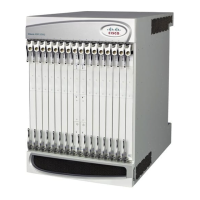Mobility Management Entity Overview
▄ Cisco ASR 5000 Series Product Overview
eNodeB
The eNodeB is the LTE base station and is one of two nodes in the SAE Architecture user plane (the other is the S-
GW). The eNodeB communicates with other eNodeBs via the X2 interface. The eNodeB communicates with the EPC
via the S1 interface. The user plane interface is the S1-U connection to S-GW. The signaling plane interface is the S1-
MME connection to MME.
Basic functions supported include:
Radio resource management, radio bearer control, and scheduling
IP header compression and encryption of user data streams
Selection of MME at UE attachment (if not determined by information sent from the UE)
Scheduling and transmission of paging messages (originated from the MME)
Scheduling and transmission of broadcast information (originated from the MME or OA&M)
Measurement & measurement reporting configuration for mobility and scheduling
Mobility Management Entity (MME)
The MME is the key control-node for the LTE access-network. The MME provides the following basic functions:
NAS
signalling
signalling security
UE access in ECM-IDLE state (including control and execution of paging retransmission)
Tracking Area (TA) list management
P-GW and S-GW selection
MME selection for handovers with MME change
SGSN selection for handovers to 2G or 3G 3GPP access networks
Terminates interface to HSS (S6a)
Authentication
Bearer management functions including dedicated bearer establishment
HRPD access node (terminating S101 reference point) selection for handovers to HRPD
Transparent transfer of HRPD signalling messages and transfer of status information between E-UTRAN and
HRPD access, as specified in the pre-registration and handover flows

